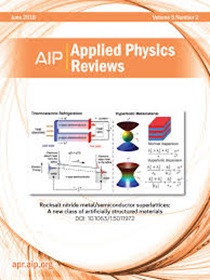Application and prospect of in situ TEM in wide bandgap semiconductor materials and devices
IF 11.9
1区 物理与天体物理
Q1 PHYSICS, APPLIED
引用次数: 0
Abstract
Wide bandgap semiconductor (WBS) materials have a wide range of applications in radio frequency and power electronics due to their many advantages such as high saturation drift velocity, breakdown voltage, and excellent thermal/chemical stability. Diamond, Ga2O3, GaN, and SiC are typical WBS materials. Reliability studies for these four materials and devices are crucial for WBS applications. Traditional means of reliability studies include, but are not limited to, x-ray diffraction, atomic force microscopy, Raman spectroscopy, and electron microscopy et al. However, most of these methods are ex situ studies after material or device failure and thus have some limitations. In situ transmission electron microscope (TEM) is a favorable technology to observe the degradation and failure process of materials and devices in real time, which may provide effective guidance in material growth, device structure design, device process optimization, and reliability improvement. In recent years, in situ TEM technology has been gradually used by researchers to study WBS materials and devices. In this review, we present a comprehensive and systematic review of in situ TEM works on diamond, Ga2O3, GaN, and SiC materials and devices, with a particular focus on the progress of the technology in the reliability study of such materials and devices. While summarizing the advantages of in situ TEM in the investigation of WBS materials and devices, the review also looks forward to the future of in situ TEM in promoting the study of WBS materials and devices.原位瞬变电磁法在宽禁带半导体材料和器件中的应用与展望
宽带隙半导体(WBS)材料由于具有高饱和漂移速度、击穿电压和优异的热/化学稳定性等优点,在射频和电力电子领域有着广泛的应用。金刚石、Ga2O3、GaN和SiC是典型的WBS材料。这四种材料和器件的可靠性研究对于WBS的应用至关重要。传统的可靠性研究手段包括但不限于x射线衍射、原子力显微镜、拉曼光谱和电子显微镜等。然而,这些方法大多是材料或设备失效后的非原位研究,因此有一定的局限性。原位透射电子显微镜(TEM)是一种实时观察材料和器件降解和失效过程的有利技术,可为材料生长、器件结构设计、器件工艺优化和可靠性提高提供有效指导。近年来,原位透射电镜技术逐渐被研究人员用于WBS材料和器件的研究。在这篇综述中,我们对金刚石、Ga2O3、GaN和SiC材料和器件的原位透射电镜工作进行了全面和系统的回顾,特别关注了该技术在这些材料和器件可靠性研究中的进展。在总结原位透射电镜在WBS材料和器件研究中的优势的同时,展望了原位透射电镜在促进WBS材料和器件研究方面的未来。
本文章由计算机程序翻译,如有差异,请以英文原文为准。
求助全文
约1分钟内获得全文
求助全文
来源期刊

Applied physics reviews
PHYSICS, APPLIED-
CiteScore
22.50
自引率
2.00%
发文量
113
审稿时长
2 months
期刊介绍:
Applied Physics Reviews (APR) is a journal featuring articles on critical topics in experimental or theoretical research in applied physics and applications of physics to other scientific and engineering branches. The publication includes two main types of articles:
Original Research: These articles report on high-quality, novel research studies that are of significant interest to the applied physics community.
Reviews: Review articles in APR can either be authoritative and comprehensive assessments of established areas of applied physics or short, timely reviews of recent advances in established fields or emerging areas of applied physics.
 求助内容:
求助内容: 应助结果提醒方式:
应助结果提醒方式:


